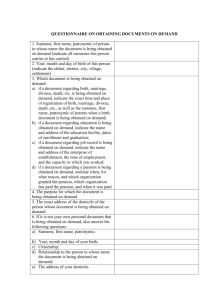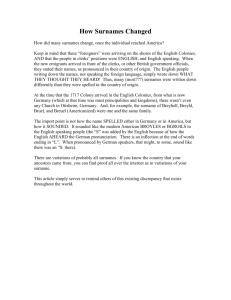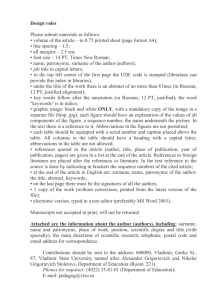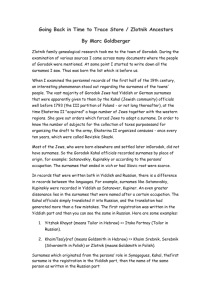3.6.2 Leiteses Genealogy Book
advertisement
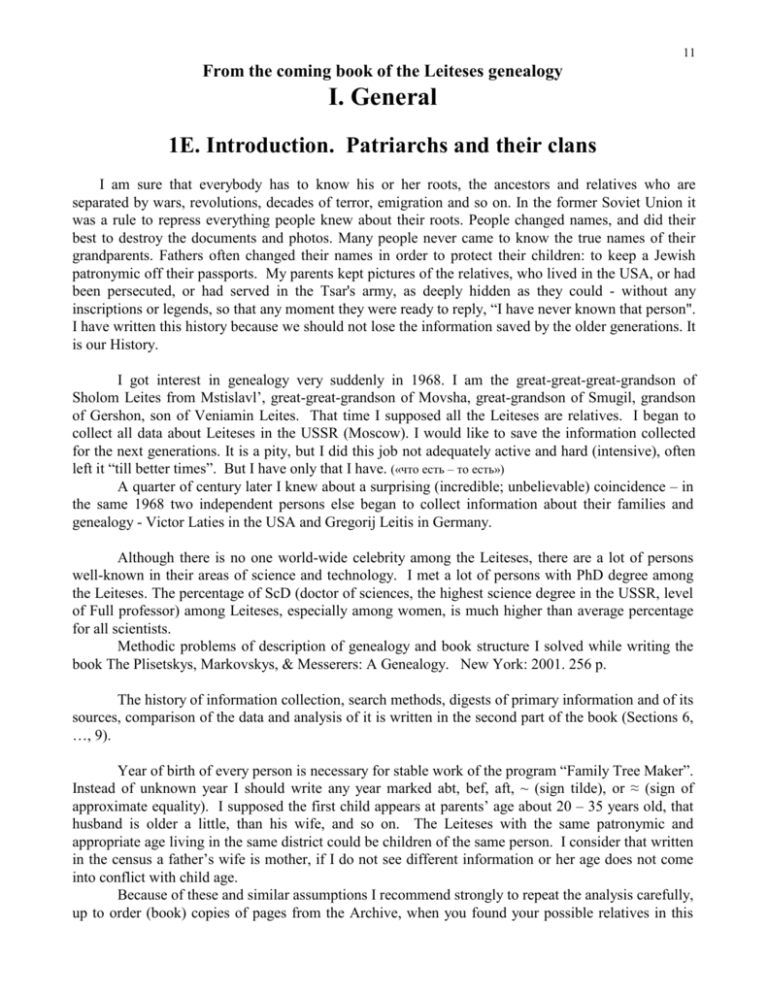
11
From the coming book of the Leiteses genealogy
I. General
1E. Introduction. Patriarchs and their clans
I am sure that everybody has to know his or her roots, the ancestors and relatives who are
separated by wars, revolutions, decades of terror, emigration and so on. In the former Soviet Union it
was a rule to repress everything people knew about their roots. People changed names, and did their
best to destroy the documents and photos. Many people never came to know the true names of their
grandparents. Fathers often changed their names in order to protect their children: to keep a Jewish
patronymic off their passports. My parents kept pictures of the relatives, who lived in the USA, or had
been persecuted, or had served in the Tsar's army, as deeply hidden as they could - without any
inscriptions or legends, so that any moment they were ready to reply, “I have never known that person".
I have written this history because we should not lose the information saved by the older generations. It
is our History.
I got interest in genealogy very suddenly in 1968. I am the great-great-great-grandson of
Sholom Leites from Mstislavl’, great-great-grandson of Movsha, great-grandson of Smugil, grandson
of Gershon, son of Veniamin Leites. That time I supposed all the Leiteses are relatives. I began to
collect all data about Leiteses in the USSR (Moscow). I would like to save the information collected
for the next generations. It is a pity, but I did this job not adequately active and hard (intensive), often
left it “till better times”. But I have only that I have. («что есть – то есть»)
A quarter of century later I knew about a surprising (incredible; unbelievable) coincidence – in
the same 1968 two independent persons else began to collect information about their families and
genealogy - Victor Laties in the USA and Gregorij Leitis in Germany.
Although there is no one world-wide celebrity among the Leiteses, there are a lot of persons
well-known in their areas of science and technology. I met a lot of persons with PhD degree among
the Leiteses. The percentage of ScD (doctor of sciences, the highest science degree in the USSR, level
of Full professor) among Leiteses, especially among women, is much higher than average percentage
for all scientists.
Methodic problems of description of genealogy and book structure I solved while writing the
book The Plisetskys, Markovskys, & Messerers: A Genealogy. New York: 2001. 256 p.
The history of information collection, search methods, digests of primary information and of its
sources, comparison of the data and analysis of it is written in the second part of the book (Sections 6,
…, 9).
Year of birth of every person is necessary for stable work of the program “Family Tree Maker”.
Instead of unknown year I should write any year marked abt, bef, aft, ~ (sign tilde), or ≈ (sign of
approximate equality). I supposed the first child appears at parents’ age about 20 – 35 years old, that
husband is older a little, than his wife, and so on. The Leiteses with the same patronymic and
appropriate age living in the same district could be children of the same person. I consider that written
in the census a father’s wife is mother, if I do not see different information or her age does not come
into conflict with child age.
Because of these and similar assumptions I recommend strongly to repeat the analysis carefully,
up to order (book) copies of pages from the Archive, when you found your possible relatives in this
12
book. I entered such doubtful (marked ~, ?, or ??) possible ties knowingly (meaningly, wittingly)),
because of to break a false tie off is very much easier than to find a hidden possible tie.
I must underline that absence of signs of doubt does not mean absolute (complete) reliability of
information. Very often the age of children was distorted in census in prevision of future recruitment
for boys or marriage for girls. Sometimes son was attached to other parents, who had no own sons –
the only son was not taken in soldiers. A lot of false death certificates were issued by Soviet Union
officials. Unintentional (accidental) mistakes in documents and data distortions in a person memory
are possible.
The genealogy tree of every clan or family is reproduced in the book in the form Family Tree
Outline List (Third part, sections 11 – 30). Such listing is compact; it can be easily paginated; it allows
including considerable data about any person, in such form persons do not need sequence numbers,
which changes if an unknown before relative is found. This part is crucial in the book; it is a base for
Index (Alphabet lists). The presence of additional information about the person, his or her photos and
so on in Fourth – Sixth parts of the book and in Enclosures are marked in the lists. The lists and
Family Tree Charts are arranged (laid out, drawn up) with help of the program Family Tree Maker Version 10 (FTM-10).
A chart of the family tree provides a clear visual representation of the clan or family structure.
Such charts are placed in Enclosure E31 in the second volume. The marital relations between the
families are shown in the end of Enclosure E31.
(((The next 3 paragraphs will be deleted:
A chart of the family tree of the clan or family – a patriarch and his descendants including
spouses. Such a chart provides a clear visual representation, but it is rather cumbersome even when
containing only a limited amount of details.
1. An outline family list of the clan (listing from the left to the right of the chart). This part is crucial in
the book; it is a base for Index (Alphabet lists). The presence of additional information about the
person, his or her photos and so on in Fifth – Seventh parts of the book and in Enclosures are marked
in the lists. Such listing can be easily paginated and allows including considerable data about any
person, but the ties between far persons are not visual easy.
The marital relations between the families are shown in section 30 (in Third part of the book).)))
List of clans and families is in Table 1. Turn (queue) of them here and in all parts and
sections of the book corresponds to their sizes approximately. Majority (The most) of the
Leiteses-jews clans and families descend from a limited area of Moghilev province (SE part of
Bielorussia), but I do not have information about relative (blood) ties between them. Such ties are
possible. An ancient clan of Gregorius Leitis from Upper Zapadnaya Dvina in Baltic is included
too. In addition I include the clan of my great-grandfather Abram-Gilel’ Malev, father of wife of
Gershon Leites.
13
Таблица 1. Родоначальники и их потомки.
Table 1. Patriarchs and their clans
Родоначальник
(поколение № 1)
Patriarch
(generation No 1)
Лейтесы:
The Leiteses:
Шолом из Мстиславля
Sholom from Mstislavl
Яков из Толочина
Yakov from Tolochin
Соломон из Смольян
Solomon from Smolyany
Буня из Смольян (данные Левине)
Bunya from Smolyany (Levine data)
Мовша из Хисловичи.
Movsha from Khislavichi
Янкель из Мстиславского уезда *
Yankel from Mstislavl uezd*
Лейба из Хисловичи *
Leiba from Khislavichi*
Лейба из Хисловичи
Leiba from Khislavichi
Яков из Веселых Тернов
Yakov from Veselye Terny
Абрам -Хаим из Петровичей
Abram-Khaim Leites from Petrovichi
Вульф из Мстиславля*
Vulf from Mstislavl
Завель из Хисловичи.*
Zavel from Khislavichi*
Отец. из Киева
Father from Kiev
Залман из Гомеля
Zalman from Gomel
Иосиф из Смольян (от Левине)
Iosif from Smolyany
Малые семьи по данным Архива*
Small families from Archives*
Малые семьи по иным источникам
Small families from other sources
Всего в родах и семьях Лейтесов
All Leites clans and families
Грегориус Лейтис с Верхн. Двины
Gregorius Leitis from upper Dvina
Абрам-Гилель Малев из Гомеля
Abram-Gilel’ Malev from Gomel
Всего в книге
Total in the book
–
Год рожд.
родоначальника
The year of
birth of the
patriarch
1750
Количество1
The number of persons1
Членов
Кровных
Повторода2
потомков3
ров4
DescenRepetiTotal2
dants3
tions4
1830
411
180+225+6
137
1840
120
1800
110
1740
47
1740
40
1760
30
1880
31
1853
30
1880
21
1760
20
1760
20
1850
15
1880
13
1830
11
306
180+120+6
15
7+8
31
25
Номера
Sequential numbers
РаздеСтраниц
лов
Sections
Pages
11 &
E31.1
12 &
E31.2
13 &
E31.3
14 &
E31.4
15 &
E31.5
16 &
E31.6
17 &
E31.7
18 &
E31.8
19 &
E31.9
20 &
E31.10
21 &
E31.11
22 &
E31.12
23 &
E31.13
24 &
E31.14
25 &
E31.15
26 &
E31.16
27 &
E31.17
900
1100
80
1852
190
85
28 &
E31.18
29 &
E31.19
1120
* Information from Belorussia archive only. Сведения есть только из переписей и иных архивных дел 19-го века.
1
– Numbers of males, females and persons of unknown sex (if any) are shown in the second line in the box.
2
– Including spouses, adopted children and their families.
3
– Only direct descendants are taken into account, excluding spouses, the adopted children, and patriarch himself.
4
– The repetitions are caused by marital relations, adoption of relatives, and so on.
14
Notes to table 1in Russian are shown in section 1R. Примечания по-русски приведены в разделе 1R на стр.22.
Distances of towns or areas mentioned from Mstislavl are equal:
Tolochin
Smolyany
Khislavichi = Khoislavich
Petrovichi
Kiev
Gomel = Homel
Veselye Terny
Upper Dvina
–
–
–
–
–
–
–
–
130 km (80 miles) to NWW,
110 km (70 miles) to NW (30 km to NE from Tolochin),
30 km (20 miles) to NE,
25 km (15 miles) to E,
400 km (250 miles) to S,
180 km (110 miles) to S,
650 km (400 miles) to S (120 km to SW from Dniepropetrovsk = Ekaterinoslav),
200-400 km (150 - 250 miles) to NW.
The 14 clans and about 60 separate families of the Leiteses listed in the Table 1 make in total
about 900 persons, including 480 males, 400 females, and 20 persons, whose sex is unknown. Among
all 900 persons 700 are Leites in blood, 10 are adopted children, 70 are husbands, and 120 are wives.
The main data about the clans were given by the next persons:
Clan of Sholom – Samuil Moiseevich Leites in 1968 – about first forefathers and branch of Lejba Movshovich.
– Bela Grigor’evna Leites in 1968 – about branches of Shlyoma Smugilevich and Gerson Smugilevich.
– Natan Semyonovich Leites in 1969 – about branch of Nota.
– Nekhama Shlyomovns Leites in 1969 – about branch of Shlyoma Smugilevich.
– Mira Erukhimovna Bolotina in 1998 – about branch of Masya Smugilevna (Masha Ratner).
– Victor Laties in 1990 – about branch of Shmaya Gershonovich (Simon Laties).
Clan of Yakov from Tolochin – Natan Solomonovich Leites in 1970 – about clan of Yakov and branch of Sholom.
– Abram (Aleksandr) Grigor’evich Leites and his wife Aelita in 1999 – about branch of Paya
Yakovlevna Leites.
– Aleksandr Moiseevich Leites in 1990 – about all clan of Yakov (a table 4 pages).
– Irina Yakovlevna Leites (Marder) in 1970 – about branch of Iche (Isaak) Yakovlevich.
– Basya Yakovlevna Leites (Shchyokina) in 1983 – about branches of Iche (Isaak), Gitl and Geneshe.
– Raisa Yakovlevna Leites in 1983, Galina Isaakovna Fridman (Leites) in 2003, Oksana Zakharovna
Korotkina in 1999 – about their families members and some relatives.
Clan of Solomon – Il’ya Solomonovich (great-grandson) Leites in 1977 - about branch of El’ya Solomonovich.
– Veniamin Grigor’evich Leites in 1991 - about branch of Mendel’ (Moisej) Solomonovich.
– Sof’ya Sholomovna Leites (Teller) in 2003 - about branch of Mendel’ Solomonovich.
Clan of Movsha – Evel Abramovich Leites in 1983 - about branch of Meishe-Yanki (Moisej).
Clan of Lejba – Klara Filippovna Leites (Tarley) in 1998.
Clan of Yakov from Veselye Terny – Nataliya Samojlovna Leites (Leytes) in 1988.
Clan of Abram-Khaim – Viktor L’vovich Leites in 1995.
Clan from Kiev – Mishel Leytes through his daughter Virginia Leytes in 1997
Clan of Zalman – Eva Zalmanovna Leites in 1992, Boris Semyonovich and Maja Isaakovna Shnitman (Leites) in 1993.
Clan of Iosif – Jimmy Levine in 1997.
Clan of Gregorius Leitis – Gregory von Leitis in 1992.
Clan of Abram-Gilel Malev – Lev Grigor’evich Leites in 1968 and 1975, Natal’ya Iosifovna Giller in 1975, Judith
Vladimirovna Maleva (Amory) in 1991.
Besides many people ascertained data about their family members and families of their siblings
and cousins by phone, letters and at meetings.
Unfortunately, in the first years of collecting data I did not have enough time for working up all
new information and in the aim at decreasing data amount I limited myself by (at?) persons bearing last
name Leites, I not enough interested about wives and women who changed their maiden name Leites.
15
2E. Transliteration
The used program “Family Tree Maker” made by Broderbund Co and, as I know, World Family
Tree Collection cannot work with Cyrillic. For this reason Family Tree charts and lists are based on the
Latin alphabet. I use Russian for the names, abbreviations, terms and so on, which are seen (visible) in
outline family tree list only.
The rules of transliteration (Table 2) are necessary for the unambiguous perception of Russian first
and last names, of geographical names and of other objects in the Latin alphabet. It must be possible to
recover the original names.
Table 2E. Transliteration between Russian and Latin letters
Russ.
А
Б
В
Г
Д
Е
Ё(1)
Ж
З
И
..ИЙ(2)
Й
К
(1)
,
Latin
Russian Latin
Russ. Latin
Russ.
A
B
V
G
D
E
YO
ZH
Z
I
…Y
J
K
Л
М
Н
О
П
Р
С
Т
У
Ф
Х
Ц
Ч
(2) (3)
,
L
M
N
O
P
R
S
T
U
F
KH
TS
CH
Ш
Щ
Ъ
Ы
Ь
Э(3)
Ю
Я
Latin
SH
SHCH
''
Y
'
E'
YU
YA
Latin
Russ.
A
А
Б
-Ч
Д
Е
Э
Ф
Г
B
C
CH
D
E
E' (3)
F
G
H
I
J
K
-И
Й
К
Latin Russian
Latin
Russ.
KH
L
M
N
O
P
Q
R
S
SH
SHCH
T
Ts
Х
Л
М
Н
О
П
-Р
C
Ш
Щ
Т
Ц
Latin
Russ.
U
V
W
X
Y
…Y(2)
YA
YO(1)
YU
Z
ZH
‘
“
У
В
--Ы
..ИЙ
Я
Ё
Ю
З
Ж
Ь
Ъ
- otherness from the Beider’s system.
The table is based on the system of transliteration used in the dictionary[1]. This system appears to
be the most unambiguous among those I know. Yet the following changes are added:
(1) To make the Russian letter Ё (the letter E with two dots on the top of it) distinguishable YO is
used.
(2) Two Russian letters ИЙ at the end of surname are changed by one Latin letter Y.
(3) For technical reasons the letter E with the sign of accent on the top of it, standing for the Russian
letter Э, has been substituted by the symbol E' (E’, E‘, E`).
(4) Letter J must be replaced by letter I in the middle of name Lejtes, which seems wrong in English.
Леитес is wrong in Russian, so mistakes are excluded.
Emigrants often have names transliterated from Russian using other rules, different in Europe and
in the USA in different decades. For example, in my passport I am Leites, but in INS documents made
by computer on the basis of the Russian spelling, and in Driver License I was Leytes during 6 years.
My uncle, who entered the USA in 1922, received the last name Laties. German pronunciation of the
name Grеgorij Leitis is exactly the same as Russian pronunciation of my son Gregory Leytes name
(Григорий Лейтес). We asked Grеgorij von Leitis and his friend to repeat his name many times and to
listen to our pronunciation of my son’s name – no difference was found. There are about 40 spelling
- A dictionary of Jewish surnames from the Russian Empire / by Alexander Beider, 1993, Avotaynu, Inc.
P.O.Box 1134
Teaneck, NJ 07666. ISBN 0-9626373-3-5, CS3010.B43 1993, 929.4’089924047—dc20, 92-46252.
Size 8.5”*11”, 784 pp. (Avotaynu, Inc. P.O.Box 99, Bergenfield, NJ 07621, USA. http://www.avotaynu.com).
[1]
16
versions (variants) for only one Russian pronunciation Лейтес. 17 of them were in use in the USA –
see table 3.
Table 3. Spelling versions of surname Leites and close of it.
Таблица 3. Версии написания фамилии Лейтес и близких к ней латинским шрифтом.
Version of
Russian Лейтес
Лейтос
spelling of
…as
…es
….ies
…is
sum
….os
the last name.
Number of persons found 1998 in the USA
Версия
by www.swithboard.com + in Family Finder FTM-5.0 (SS death index and other Archives).
написания
Количество людей с указанными фамилиями, встретившихся в США
фамилии
в списке адресов + в списке умерших и ряде других архивов
Lait….
12 + 0
5+1
0+0
4+1
21 + 2
6+2
Lajt….
0+0
0+0
0+0
0+0
0+0
3+2
Lat….
70 + 40
*54 + 46
19 + 5
5+9
*148+100
100+38
Layt….
0+0
0+1
0+0
0+1
0+2
13 + 6
Leit….
1+0
*36 + 27
0+0
15 + 10
*52 + 37
5+2
Leyt….
1+0
*12 + 5
0+0
0+0
*13 + 5
0+0
sum
84 + 40
*107+80
19 + 5
24 + 21
234 + 146
127+50
sum
124
187
24
45
380
177
Number of spelling versions in use in the USA
Количество встретившихся версий написания фамилии в США
All
4
5 +**3
1
4
14 +**3
5
* - including a version with double S, for example Latess. – включая версию со сдвоенной буквой S в конце.
** - number of versions with double S.
– количество версий со сдвоенной буквой S в конце.
The persons with surnames Latas (110 persons) and Lates (100 persons) were most often. The
majority of them had Spanish and other Western (European) given names. The persons with surname
Leites (63 persons) was the next. Some of them had Jewish given names. The majority of Leitis (25)
and Laties (24 persons) had Western names, but Leytes (17 persons) had mostly Jewish and Russian
names. At last, the majority of Latis (14 persons), Laitas (12), Laites (6), and Laitis (5 persons) had
Western and Spanish given names. This review (survey; round-up) is a very subjective estimation
because Catholics use biblical names. But among the Leitoses (Latoses and so on – 177 persons in
table 3) I did not see Jewish first names almost at all.
17
3E. Data about each person and notation
Data of every person are given in the following sequence in the family tree outline list:
First, either the number of the generation is given as counted from the patriarch, or the sign "+"
(spouse) is provided. If the person is mentioned repeatedly as a result of, say, entering into a marriage
to a member of the same clan, or the adoption of a relative, a number in brackets ([1], [2], [3].., which
helps to identify the repetition) precedes the name of such a person.
Secondly, the first name, the first letter of the patronymic or of the middle name (the initial),
and the surname are presented as written at birth.
If all over the life a different name was used, this name may be written. If the person wants, the
name he or she used later is shown instead of the name written at birth. As a rule the changed surname
is shown for person who changed the country.
If the first name is unknown, it is replaced with the words Son, Daughter, Child, Husband, or Wife.
If the surname is unknown, it is replaced by the word "Unknown".
If the name is too long, a truncated one is used for do not block up (? jam, (en)cumber, crowd;
overload ?) charts, alphabet Index, and lists. The full name follows. It includes the patronymic or of
the middle name. The patronymic is not written if it correlates with the father’s name absolutely
clearly.
If the names are shown not at birth, the names at birth are introduced by the marks “b: and till
.…”(year). After that the name changes, variants, modifications (accompanied with the date and the
reason of the change) are mentioned, pseudonyms, and nicknames (aliases) under which the given
person is known.
The same names in Cyrillic follow for the people born in the former USSR or for others whose
Russian spelling is known.
If sex is not clear from name, or spose’s name, or parents’ number of children, it must follow
names as “(M)” or “(F)”.
Next, all the following information is given:
The date and location: of birth (b:),
of marriage (m:),
of divorce (marriage ending (This is printed, although I select “Divorce”)),
of the moves to a different country (moved),
of death (d:).
Often the date is preceded by the word "about" (abt), "before" (bef), or "after" (aft), indicating its
being approximate. In the case if the date in documents was changed from Julian calendar to
Gregorian one, the Julian date is shown in brackets.
The comments may follow each of these items, such as the cause of death, the place of the burial
(buried in) if it differs from the place of death, and so on.
Persecutions, death in pogrom or Holocaust, participation of wars, ….
Profession, education, … .
Degrees, titles in science and art, awards, … .
Publications (details and examples are in section 24, here: “Publ. …” (amount)).
18
Position, employment, occupation, business, … .
Medical information.
Ancestors, relatives not shown as independent members in the family tree.
Personal features (appearance, behavior, character…).
The number of children. For example, 4s+3d+2ch+(1s) indicates the four sons, three daughters,
two children of unknown sex, and one adopted son or stepson.
The remarks about the presence of data in census (mark C), of the additional data (Ad),
documents (D), publications (P), photos (F), or essays (E) in sections 9, 31, 32, 33, 34, and Enclosures.
The designations are shown in the Table 4.
Table 4E. Abbreviations and other designations
+ = spouse
? = supposedly, not proven, a hypothetical tie
[1], [2],.. = the case number of repeating the person
Ad = the additional data existing in section 62
abt = about, circa, estimate
aft = after
bef = before
b: = born, birth
C, c = data from census and so on in section E4
ch = the number of children
D = documents, given in section 63
d = the number of daughters
d:
= died, death
div = divorce
E
= essay – data, given in Enclosure
F
= photos (Foto) in section 65
GPW = Great Patriotic War (1941-45)
m:
= marriage, married
P
= publications about the person in sect. 64
PhD = Doctor of Philosophy
Publ = an author of publications described in section 88
ScD = Doctor of Science
s
= the number of sons
WW2 = World War Second
Every cell in the family tree chart is completed with the following data (in four lines):
1. The first name and the first letter of the patronymic or the middle name (the initial) are
presented in the first line.
2. The surname is presented in the second line.
3. The dates of birth and death (without words “before”, “about”, or “after”) are presented in the
third line.
4. The number of children and the remarks about the presence data in other sections of the book
are given in the forth line. ((Нельзя ли исключить 4 повтора про строку ?))
Comments above concern data in these four lines.
The cell is shaped in accordance with the sex: women are presented in a patterned frame, and
persons of unknown sex - in a frame without corners.
A dash line frame means that the person in the frame is mentioned repeatedly as a result of, say,
entering into a marriage or adopting a member of the same clan. A number in brackets ([1], [2], [3] )
precedes the name of such a person.
Interruption of (Gap in) line before the cell means absence of blood tie with one or both of the
parents.
Tilde or question-mark in a gap of the line between the cells means that the relation with these
cells is not proven (arguable), or this tie is hypothetical only.
19
4E. Genesis of the surname. Are all of the Leiteses related?
50 000 Jewish surnames, used at the beginning of 20th century, are mentioned in The Dictionary of
Jewish Surnames in The Russian Empire by Alexander Beider (see footnote [1] in page 15).
The following information is given there:
Lein (Gomel’, Chaussy, Mogilev, Ekater. gub.) FS: from the given name Leya (’leye’ in Yddish)
{Lejn, Lejman (Liman), Leinov, Lejnov, Leenman, Leenson (Lenson), Leenzon (Lenzon), Lees (Less),
Leets, Leezon, Leinson, Leinzon, Lejnzon, Lejzon, Lejs, Lejsman, Lesman, Lejkind (Lejkin,
Lejkand)}. The original Hebrew form of this given name is ‘leyaoh’ (Genesis 29:16). Variant of this
given name: Laya (‘laye’ in Central Yiddish) {Lajnzon}. Hypocoristic forms: Lejka (‘leyke’ in
Yiddish) {Lejchenko, Lejkin (Lejkind), Lejkis, Lejkovich}, Lesha (‘leshe ’in Yiddish) {Leshin}, Lesya
(‘lesye’ in Yddish) {Lesin (Lesen, Lessin), Lesyuk (Lisyuk), Lesman}, Leska (‘leske’ in Yiddish)*
{Leska, Leskes, Leskin, Leskis}, Leshka (‘leshke’ in Yiddish)* {Leshko, Leshkin}, Lejtsa (‘leytse’ in
Yddish) {Lejtsev, Lejtsin (Lejtsyn), Lejtsis, Lejtsman, Lejtes, Lejtas (Lejtash), Lejtis, Lejtus (Lejtush),
Lejtman, Lejtin}, Lajtsa (‘laytse’ in Central Yiddish)* from Laya {Lajtsis, Latsis}. Pet form: Leechka
(‘leichke’in Yiddish)* {Leechkis, Lejchkis, Lichkus, Letskin}.
……..
Lejtas FS: see Lein. O: see Lejtejzen.
……..
Lejtejzen O: leytayzn [Yiddish] soldering iron {Lejtejzon, Lajtajzen, Lejtas}.
…….
Lejtes (common in Mstislavl’; Chernigov gub.) FS: see Lein.
…….
Lejtis FS: see Lein.
…….
Lejtus (Gomel’, Chernigov gub., Ekater. gub.) FS: see Lein.
….
Malev (Gomel’, Rechitsa, Cherikov) T: see Mogilev.
…..
Mogilev (Uman’) T: see Mogiliver. T: from the town Mogilev (‘molev’ in Yddish) {Molev (Malev,
Malov), Molever (Moliver)} (center of province) {Magalif, Mogilever, Mogilevich (Magilevich),
Mogilevskij (Magilevskij, Mogolevskij), Milov}.
– Gubernia (Province),
– Derived from a feminine given name, means “son of ...”,
– Surname derived from a toponym (place name),
– Occupational surname.
– Form not found in Kulisher’s 1911 list (Кулишер И.И. Сборник для
согласования разновидностей имен. Житомир, 1911).
Bold surnames – surnames, mentioned in this book.
Notes: gub.
FS
T:
O:
*
As you see, 62 surnames descend from the female name Leya and its variants, among them 13 –
from name Lejtsa.
20
My Aunt Bela Grigor’evna Leites told me that the word “leites” is connected with profession of
blacksmith. In The Dictionary by A. Beider a surname Lejtejzen is close to this version: “Lejtejzen O:
leytayzn [Yiddish] soldering iron {Lejtejzon, Lajtajzen, Lejtas}”.
Somebody told me that some Spaniards have last name after Spanish river Leita, but I did not
find this river in atlas. There are a town and a district Leiria in Portugal, a river Laita in Austria, a river
Leie in Belgium, 2 towns Leiton in Britain (England) and so on. The river Leita, if it exists, could give
surname to Jews too.
Leitis in the Lettish language means a Lithuanian. The last name of Gregorius Leitis (who died
at Upper Dvina in 1158 – see enclosure E1) can descend from this word.
The noble clan of his descendants can not be related to Jews. But Gregory von Leitis wrote
Nov 1, 1979 the next (E1): “After new inquires with cousin Hildegard who is well informed in family
questions, I was told that she knows by transmission through word of mouth that a member of the
Kreuzburg line (of von Leitis clan) married a Jewess in the 18th century and due to the prevailing rights
of the social position of that time lost his rights for himself and his descendants and emigrated to
Russia. Only thus I can explain at the moment why one part of the Leites in the U.S.A. is of Jewish
faith and another part is of Catholic faith. Further, this cousin also knew that these descendants were
forced to change their name and so it could also be explained why the Leitis living in the U.S.A. call
themselves Leites instead of Leitis.”
I think that the version given by Beider is correct. In the Russian Empire Jews, as a rule, had not
any surnames until the end of the 18th century. When surnames were given to Jews in Russian Empire,
no related families of Lejtsa’s sons could get the identical surnames Leites. So the same surname
Leites of different families is not an incontestable proof for relationship between these families.
On the other hand an unknown relationship could exist. For example my aunts told me that
they did not know the name of one brother of their father (my grandfather) – they knew such brother
existed, but he was at odds with the last family.
The ancestors of many of non-relatives - Leiteses lived not far from Mstislavl’ (distances are written in
page 14). The places of great-grandfathers’ birth in other families are unknown, it could be Mstislavl area.
Relative ties could exist, could not exist …. I do not know.
In conclusion I would like to underline that not all Leiteses are related each other, but I think
many ties until are not found and not proved. So, the problem is open. I hope a lot of additional
information is hidden in the State Historical Archive of Byelorussia.
The geographical maps, reflecting the situation at the beginning of 20th century and in 1966, are
given in section 5. You see many mentioned places located close each other.

